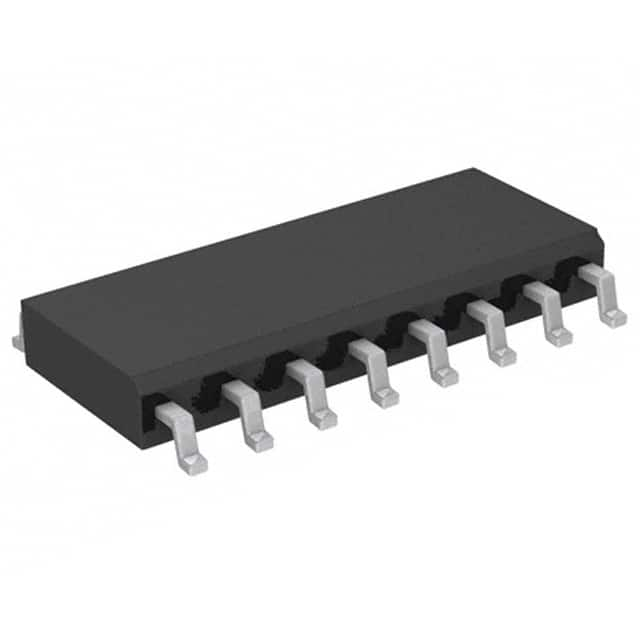Consulte las especificaciones para obtener detalles del producto.

M74HC148RM13TR
Product Overview
- Category: Integrated Circuit
- Use: Encoder
- Characteristics: High-speed, 8-line to 3-line priority encoder
- Package: SO-16
- Essence: The M74HC148RM13TR is a high-speed priority encoder that converts 8 input lines into a 3-bit binary code. It is commonly used in digital systems where multiple inputs need to be prioritized and encoded.
- Packaging/Quantity: The M74HC148RM13TR is typically packaged in reels containing 2500 units.
Specifications
- Supply Voltage: 2V to 6V
- Input Voltage: 0V to VCC
- Output Voltage: 0V to VCC
- Operating Temperature Range: -40°C to +125°C
- Propagation Delay: 20ns (max)
- Power Dissipation: 500mW (max)
Detailed Pin Configuration
The M74HC148RM13TR has a total of 16 pins arranged as follows:
- GND (Ground)
- A0 (Input Line 0)
- A1 (Input Line 1)
- A2 (Input Line 2)
- A3 (Input Line 3)
- A4 (Input Line 4)
- A5 (Input Line 5)
- A6 (Input Line 6)
- A7 (Input Line 7)
- EO (Enable Output)
- E1 (Enable Input 1)
- E2 (Enable Input 2)
- E3 (Enable Input 3)
- Y0 (Output Bit 0)
- Y1 (Output Bit 1)
- Y2 (Output Bit 2)
Functional Features
- Converts 8 input lines into a 3-bit binary code
- Prioritizes the input lines based on their order
- Provides an enable output for cascading multiple encoders
- High-speed operation suitable for time-critical applications
- Low power consumption
Advantages and Disadvantages
Advantages: - High-speed operation allows for efficient encoding of multiple inputs - Compact SO-16 package saves board space - Low power consumption helps in reducing overall system energy requirements
Disadvantages: - Limited to encoding 8 input lines only - Requires external enable inputs for cascading multiple encoders
Working Principles
The M74HC148RM13TR works by assigning priority to the input lines based on their order. The highest priority input line with a logic high signal is encoded into a 3-bit binary code at the output. The enable inputs allow for cascading multiple encoders, enabling the encoding of more than 8 input lines.
Detailed Application Field Plans
The M74HC148RM13TR is commonly used in various digital systems where multiple inputs need to be prioritized and encoded. Some application fields include:
- Data processing systems
- Communication systems
- Industrial automation
- Robotics
- Automotive electronics
Detailed and Complete Alternative Models
- SN74HC148N: Similar high-speed priority encoder from Texas Instruments, available in DIP-16 package.
- CD74HC148E: High-speed CMOS priority encoder from Texas Instruments, available in PDIP-16 package.
- 74HCT148: Priority encoder with TTL compatibility, available in various packages.
These alternative models provide similar functionality and can be used as replacements for the M74HC148RM13TR in different applications.
Word count: 408 words
Enumere 10 preguntas y respuestas comunes relacionadas con la aplicación de M74HC148RM13TR en soluciones técnicas
Sure! Here are 10 common questions and answers related to the application of M74HC148RM13TR in technical solutions:
Q: What is the M74HC148RM13TR? A: The M74HC148RM13TR is a high-speed CMOS 8-to-3 line priority encoder IC.
Q: What is the purpose of a priority encoder? A: A priority encoder is used to encode multiple inputs into a binary code, with the highest priority input being encoded first.
Q: What is the maximum operating voltage for the M74HC148RM13TR? A: The M74HC148RM13TR has a maximum operating voltage of 6V.
Q: How many inputs does the M74HC148RM13TR have? A: The M74HC148RM13TR has 8 inputs (A0-A7) and 3 outputs (Y0-Y2).
Q: What is the output format of the M74HC148RM13TR? A: The outputs of the M74HC148RM13TR are active low, meaning they are inverted versions of the encoded binary code.
Q: Can the M74HC148RM13TR be cascaded to handle more than 8 inputs? A: Yes, multiple M74HC148RM13TR ICs can be cascaded together to handle larger numbers of inputs.
Q: What is the propagation delay of the M74HC148RM13TR? A: The typical propagation delay of the M74HC148RM13TR is around 15 ns.
Q: Is the M74HC148RM13TR suitable for high-speed applications? A: Yes, the M74HC148RM13TR is designed for high-speed operation and can be used in applications that require fast encoding.
Q: Does the M74HC148RM13TR have any built-in error detection or correction features? A: No, the M74HC148RM13TR is a basic priority encoder and does not include error detection or correction capabilities.
Q: What are some common applications of the M74HC148RM13TR? A: The M74HC148RM13TR is commonly used in digital systems where multiple inputs need to be encoded into a binary code, such as in address decoding, data multiplexing, and interrupt handling circuits.
Please note that these answers are general and may vary depending on the specific requirements and datasheet of the M74HC148RM13TR.

